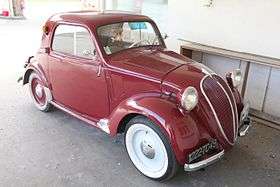Simca 5
| Simca 5 | |
|---|---|
 | |
| Overview | |
| Manufacturer | Simca |
| Production | 1936 - 1948 |
| Assembly | Nanterre, France |
| Body and chassis | |
| Class | Small car |
| Body style | 2-door saloon |
| Layout | FR layout |
| Related | Fiat Topolino |
| Powertrain | |
| Engine | I4 570 cc |
| Transmission | 4-speed manual |
| Dimensions | |
| Wheelbase | 2,000 mm (78.7 in)[1] |
| Length | 3,220 mm (126.8 in) |
| Width | 1,350 mm (53.1 in) |
| Height | 1,400 mm (55.1 in) |
| Chronology | |
| Successor | Simca 6 |
The Simca 5 is a small Franco-Italian passenger car designed, by Fiat engineers at Turin. It was produced and sold in France by Simca. It was virtually identical to the Fiat 500 Topolino on which it was based, but was first presented, at the company's new Nanterre plant, three months ahead of the Fiat equivalent on 10 March 1936. Production was delayed, however, by a wave of strikes, that accompanied the June 1936 electoral victory of Léon Blum's Popular Front government. The manufacturer boasted at the time of its launch of being ahead of the "plans across the Rhine": this was a reference to the already rumoured launch of the Volkswagen Beetle which would appear only in 1938.
Advanced features included independent front suspension, a four speed gear box, hydraulically controlled drum brakes on all four wheels and a twelve volt electrical system. The Simca 5 also offered exceptional fuel economy (in a test it managed to travel 110 kilometers on just 5 litres of fuel).
The car was originally intended for sale on the domestic market for less than 10,000 French Francs, an aspiration soon overtaken by a decline in the currency's value that gathered pace in the second half of the 1930s. By the time of the 32nd Paris Motor Show in October 1938, the manufacturer's listed price even for the base "standard" bodied car, was 13,980 francs.[2] With an engine size that corresponded with the 3CV car tax band the Simca 5, along with its Fiat sibling, could be presented as the "smallest volume production car in the world".[3]
Production of the Simca 5 was slowed down (but did not ever cease entirely) by the war and the period of German occupation in the early 1940s, but resumed in 1946. 46,472 of the cars had been produced by the time the car was delisted by Simca in 1949. By now it had been replaced on the company's production lines by the similar but partially reskinned and slightly more powerful Simca 6.
- This entry is based on a translation of the French Wikipedia corresponding entry
Sources and further reading
- ↑ "Automobilia". Toutes les voitures françaises 1948 (salon Paris oct 1947). Paris: Histoire & collections. Nr. 7: Page 74. 1998.
- ↑ "Automobilia". Toutes les voitures françaises 1939 (salon Paris oct 1938). Paris: Histoire & collections. Nr. 11: Pages 85–86. 1999.
- ↑ "Automobilia". Toutes les voitures françaises 1939 (salon Paris oct 1938). Paris: Histoire & collections. Nr. 11: Pages 85–86. 1999 "Son moteur miniscule en fait le plus petite voiture de série du monde (avec, bien sûr, la Fiat Topolino dont elle dérive)". Check date values in:
|date=(help)
| Wikimedia Commons has media related to Simca 5. |